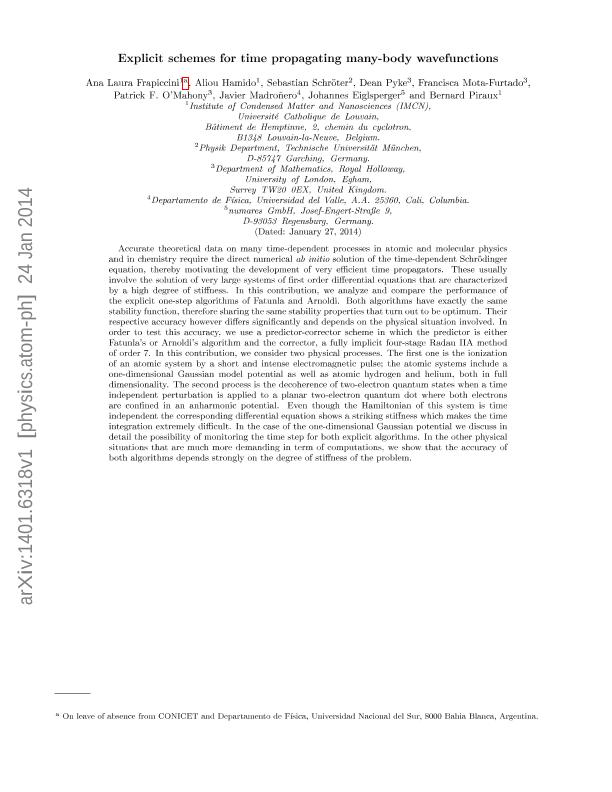Artículo
Explicit schemes for time propagating many-body wave functions
Frapiccini, Ana Laura ; Hamido, Aliou; Schröter, Sebastian; Pyke, Dean; Mota Furtado, Francisca; O’Mahony, Patrick F.; Madroñero, Javier; Eiglsperger, Johannes; Piraux, Bernard
; Hamido, Aliou; Schröter, Sebastian; Pyke, Dean; Mota Furtado, Francisca; O’Mahony, Patrick F.; Madroñero, Javier; Eiglsperger, Johannes; Piraux, Bernard
 ; Hamido, Aliou; Schröter, Sebastian; Pyke, Dean; Mota Furtado, Francisca; O’Mahony, Patrick F.; Madroñero, Javier; Eiglsperger, Johannes; Piraux, Bernard
; Hamido, Aliou; Schröter, Sebastian; Pyke, Dean; Mota Furtado, Francisca; O’Mahony, Patrick F.; Madroñero, Javier; Eiglsperger, Johannes; Piraux, Bernard
Fecha de publicación:
14/02/2014
Editorial:
American Physical Society
Revista:
Physical Review A: Atomic, Molecular and Optical Physics
ISSN:
1050-2947
e-ISSN:
1094-1622
Idioma:
Inglés
Tipo de recurso:
Artículo publicado
Clasificación temática:
Resumen
Accurate theoretical data on many time-dependent processes in atomic and molecular physics and in chemistry require the direct numerical ab initio solution of the time-dependent Schrödinger equation, thereby motivating the development of very efficient time propagators. These usually involve the solution of very large systems of first-order differential equations that are characterized by a high degree of stiffness. In this contribution, we analyze and compare the performance of the explicit one-step algorithms of Fatunla and Arnoldi. Both algorithms have exactly the same stability function, therefore sharing the same stability properties that turn out to be optimum. Their respective accuracy, however, differs significantly and depends on the physical situation involved. In order to test this accuracy, we use a predictor-corrector scheme in which the predictor is either Fatunla's or Arnoldi's algorithm and the corrector, a fully implicit four-stage Radau IIA method of order 7. In this contribution, we consider two physical processes. The first one is the ionization of an atomic system by a short and intense electromagnetic pulse; the atomic systems include a one-dimensional Gaussian model potential as well as atomic hydrogen and helium, both in full dimensionality. The second process is the decoherence of two-electron quantum states when a time-independent perturbation is applied to a planar two-electron quantum dot where both electrons are confined in an anharmonic potential. Even though the Hamiltonian of this system is time independent the corresponding differential equation shows a striking stiffness which makes the time integration extremely difficult. In the case of the one-dimensional Gaussian potential we discuss in detail the possibility of monitoring the time step for both explicit algorithms. In the other physical situations that are much more demanding in term of computations, we show that the accuracy of both algorithms depends strongly on the degree of stiffness of the problem.
Palabras clave:
TDSE
,
Explicit propagator
,
Arnoldi
,
Runge-Kutta
Archivos asociados
Licencia
Identificadores
Colecciones
Articulos(IFISUR)
Articulos de INSTITUTO DE FISICA DEL SUR
Articulos de INSTITUTO DE FISICA DEL SUR
Citación
Frapiccini, Ana Laura; Hamido, Aliou; Schröter, Sebastian; Pyke, Dean; Mota Furtado, Francisca; et al.; Explicit schemes for time propagating many-body wave functions; American Physical Society; Physical Review A: Atomic, Molecular and Optical Physics; 89; 2; 14-2-2014; 1-15
Compartir
Altmétricas



